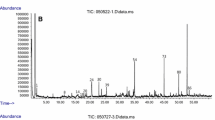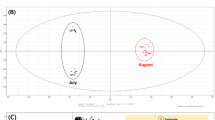Abstract
An ethyl acetate extract of Oryza sativa (rice) hulls yielded seven compounds: hentriacontane, 1-tetratriacontanol, β-sitosterol, momilactone A, momilactone B, tricin (a flavonoid), and β-sitosterol-3-O-β-d-glucoside. The structures of these compounds were elucidated with 500 MHz nuclear magnetic resonance (NMR), using 1D and 2D spectral methods, aided by electron ionization mass spectrometry (EI–MS), fast atom bombardment mass spectrometry (FAB–MS), infrared (IR), and ultraviolet (UV) spectrophotometry. The complete 1H NMR assignments for momilactone A and B and 13C NMR assignments for tricin are discussed. To the best of our knowledge, hentriacontane, 1-tetratriacontanol, and β-sitosterol-3-O-β-d-glucoside were identified for the first time in rice hulls. In biological activity tests using these identified compounds, momilactone A and B showed potent inhibitory activity against duckweed (Lemna paucicostata). 1-Tetratriacontanol and β-sitosterol-3-O-β-d-glucoside also showed about 13–20% inhibitory activity based on chlorophyll reduction. Hentriacontane and β-sitosterol did not show any herbicidal activity. In a germination assay of three weed species (Leptochloa chinenesis L., Amaranthus retroflexus L., and Cyperus difformis L.) in culture tubes both momilactones A and B had high inhibitory effects. Momilactone B completely inhibited germination of all three weed species at 20 ppm. Germination of L. chinensis L. was completely inhibited by a 4 ppm solution of momilactone B.

Similar content being viewed by others
References
V. K. Agnihotri S. D. Srivastava S. K. Srivastava S. Pitre K. Rusia (1987) ArticleTitleConstituents from the seeds of Cordia oblique as potential anti-inflammatory agents Ind. J. Pharm. Sci. 49 66–69 Occurrence Handle1:CAS:528:DyaL2sXlvFSmtrs%3D
D. W. Cartwright P. Langcake R. J. Pryce D. P. Leworthy J. P. Ride (1981) ArticleTitleIsolation and characterization of two phytoalexins from rice as momilactones A and B Phytochemistry 20 535–537 Occurrence Handle10.1016/S0031-9422(00)84189-8 Occurrence Handle1:CAS:528:DyaL3MXkt1Whtbw%3D
J. S. Choi J. S. Kim B. H. Lee J. S. Kim K. Y. Cho (2002) ArticleTitleHighly efficient screening of herbicidal substances through germination inhibition of small seeds Korean J. Weed Sci. 22 399–413
A. K. Dutta (1973) ArticleTitleGermination and growth-inhibitors in relation to nonviability of rice seeds Ind. J. Agric. Sci. 42 894–900
H. Hashimoto M. Tori Y. Asakawa (1991) ArticleTitlePiscidal sterol acylglucosides from Edgenworthia chrysantha Phytochemistry 30 2927–2931 Occurrence Handle10.1016/S0031-9422(00)98226-8 Occurrence Handle1:CAS:528:DyaK38XhvVeltQ%3D%3D
J. D. Hiscox G. F. Israelstam (1979) ArticleTitleA method for the extraction of chlorophyll from leaf tissue without maceration Can. J. Bot. 57 1332–1334 Occurrence Handle1:CAS:528:DyaE1MXltlKlsbg%3D
K. S. Hong B. H. Lee K. H. Lee I. T. Hwang J. S. Kim K. Y. Cho (2000) ArticleTitleGrowth response of duckweed (Lemna paucicostata Hegelm 381) and cyanobacteria (Anacystis nidulans R2) to several herbicides Korean J. Weed Sci. 20 225–234
T. Kato C. Kabuto N. Sasaki M. Tsunagawa H. Aizawa K. Fujita Y. Kato Y. Kitahara (1973) ArticleTitleMomilactones, growth inhibitors from rice, Oryza sativa L Tetrahedron Lett. 39 3861–3864 Occurrence Handle10.1016/S0040-4039(01)87058-1
T. Kato M. Tsunakawa N. Sasaki H. Aizawa K. Fujita Y. Kitahara N. Takahashi (1977) ArticleTitleGrowth and germination inhibitors in rice husks Phytochemistry 16 45–48 Occurrence Handle10.1016/0031-9422(77)83010-0 Occurrence Handle1:CAS:528:DyaE2sXhtlKgt7s%3D
H. Kato-Noguchi T. Ino (2003) ArticleTitleRice seedlings release momilactone B into the environment Phytochemistry 63 551–554 Occurrence Handle10.1016/S0031-9422(03)00194-8 Occurrence Handle1:CAS:528:DC%2BD3sXksVGns7k%3D Occurrence Handle12809715
H. Kato-Noguchi T. Ino N. Sata S. Yamamura (2002) ArticleTitleIsolation and identification of a potent allelopathic substance in rice root exudates Physiol. Plant. 115 401–405 Occurrence Handle10.1034/j.1399-3054.2002.1150310.x Occurrence Handle1:CAS:528:DC%2BD38XlsVGitL8%3D Occurrence Handle12081533
O. Kodama T. Suzuki J. Miyakawa T. Akatsuka (1988) ArticleTitleUltraviolet-induced accumulation of phytoalexin in rice leaves Agric. Biol. Chem. 52 2469–2473 Occurrence Handle1:CAS:528:DyaL1cXmt1Grt7w%3D
O. Kodama J. Miyakawa T. Akatsuka S. Kiyosawa (1992) ArticleTitleSakuranetin, a flavanone phytoalexin from ultraviolet-irradiated rice leaves Phytochemistry 31 3807–3809 Occurrence Handle10.1016/S0031-9422(00)97532-0 Occurrence Handle1:CAS:528:DyaK3sXlsFWrsQ%3D%3D
K. S. Mukherjee C. K. Chakraborty T. P. Chatterjee P. Bhattacharya (1989) ArticleTitleChemical examination of Cassia pumila Lam J. Ind. Chem. Soc. 66 66–67 Occurrence Handle1:CAS:528:DyaL1MXlslWisbY%3D
N. Ramarathnam T. Osawa M. Namiki S. Kawakishi (1988) ArticleTitleChemical studies on novel rice hull antioxidants. 1. Isolation, fractionation and partial characterization J. Agric. Food Chem. 36 732–737 Occurrence Handle10.1021/jf00082a014 Occurrence Handle1:CAS:528:DyaL1cXksFWrsLo%3D
N. Ramarathnam T. Osawa M. Namiki S. Kawakishi (1989) ArticleTitleChemical studies on novel rice hull antioxidants. 2. Identification of isovitexin, a C-glycosyl flavonoid J. Agric. Food Chem. 37 316–319 Occurrence Handle10.1021/jf00086a009 Occurrence Handle1:CAS:528:DyaL1MXhtleqsL8%3D
SAS Institute. 2000 User’s Guide: Basics, 5th edn. SAS Institute. Cary, North Carolina.
H. K. Song J. K. Ahn A. Ahmad S. J. Hahn S. J. Kim I. M. Chung (2004) ArticleTitleIdentification of allelochemicals in rice root exudates at various phenological phases and their influence on barnyard grass Allelopathy J. 13 173–188
N. Takahashi T. Kato M. Tsunagawa N. Sasaki Y. Kitahara (1976) ArticleTitleMechanism of dormancy in rice seeds. II. New growth inhibitors, momilactones A and B isolated from the hulls of rice seeds Jpn. J. Plant Breeding 26 91–98 Occurrence Handle1:CAS:528:DyaE1cXntFGjtA%3D%3D
J. L. C. Wright A. G. Mcinnes S. Shimizu D. G. Smith Kahashi J. A. Walter D. Idler W. Khalil (1978) ArticleTitleIdentification of C24 alkyl epimers of marine sterols by 13C nuclear magnetic resonance spectroscopy Can. J. Chem. 56 1898–1903 Occurrence Handle1:CAS:528:DyaE1cXlvFOrsr8%3D
Acknowledgment
The authors wish to acknowledge in the financial support of the Rural Development Administration made in the Biogreen 21 project year of 2004.
Author information
Authors and Affiliations
Corresponding author
Electronic supplementary material
Rights and permissions
About this article
Cite this article
Chung, IM., Hahn, SJ. & Ahmad, A. Confirmation of Potential Herbicidal Agents in Hulls of Rice, Oryza sativa. J Chem Ecol 31, 1339–1352 (2005). https://doi.org/10.1007/s10886-005-5290-5
Received:
Revised:
Accepted:
Published:
Issue Date:
DOI: https://doi.org/10.1007/s10886-005-5290-5




